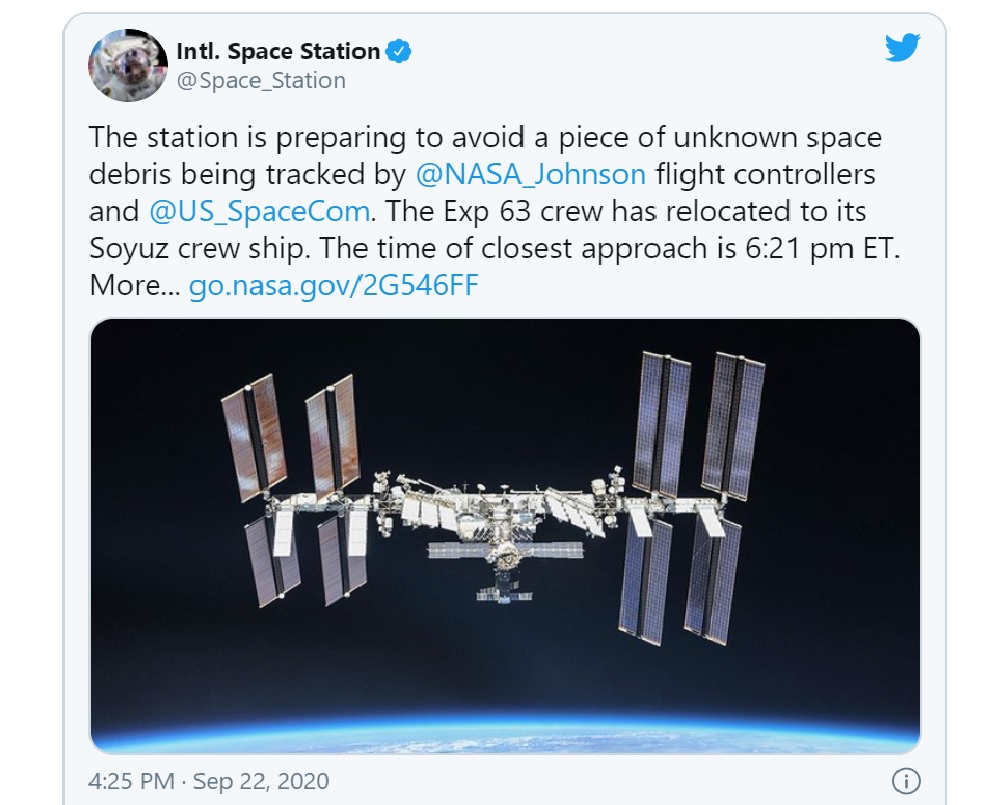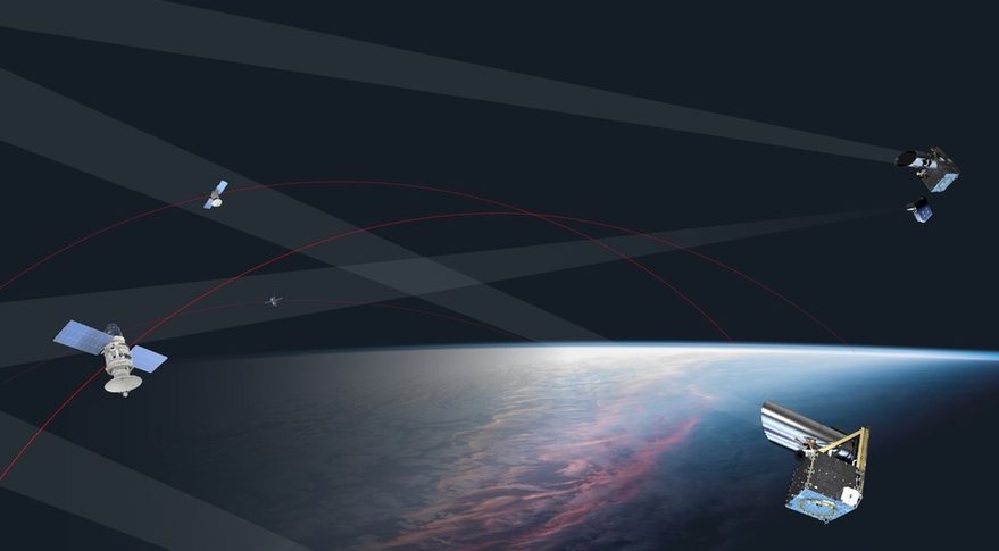Science
Canadian company to help track satellites and 'space junk' – Radio Canada International – English Section
Space, at least around Earth is not a big empty place. In fact with hundreds of thousands of objects now hurtling the planet in orbit, its become extremely crowded. A computer-generated image representing space debris as could be seen from high Earth orbit. The two main debris fields are the ring of objects in geosynchronous Earth orbit (GEO) and the cloud of objects in low Earth orbit (LEO). (image NASA Orbital Debris Prgm Office)
If you counted all the satellites put into space since ‘Sputnik’ in 1957, you’d find that about half of them, roughly 5,000 are still up there speeding around the Earth in various trajectories and at various heights. Added to this are the occasional lost bolt, spatula, 15kg tool bag with tools, camera, and pliers.
Also spinning around are spent boosters and parts of other space stations, and debris from past collisions of ‘stuff’. In 2009 a Russian military satellite crashed into a US commercial satellite creating a cloud of about 600 more bits of various sizes sent off in new directions and trajectories.


The US space shuttle Endeavour had a major impact on its radiator during STS-118. The entry hole is about 1⁄4 inch, and the exit hole is twice as large..
All this orbiting debris is monitored from the ground and tracked so that hopefully it won’t result in destruction of operational satellites, the International Space Station, or even astronauts on space walks.
In fact NASA has an ‘orbital debris program office‘ to keep track of the clutter, now in the order of about half a million bits, some 23,000 of which are bigger than a softball. But NASA is only one of many government and private tracking operations.
When objects appear to be on a collision course there is sometimes a possibility to move them out of the way. This was the case for the ISS in September which took evasive action and the astronauts evacuated temporarily to the Russian pace capsule, in case.


ISS tweet Sept 22. 2020
But ground tracking isn’t as accurate as satellite operators would like. It can also be blocked out by weather conditions.
A Canadian company is proposing a series of space-based tracking satellites to provide more accurate data of objects and trajectories.
Montreal-based NorthStar Earth and Space has contracted Thales Alenia to build the first three of a planned 12 satellite ‘Skylark’ constellation system to monitor ‘space traffic’.Seattle-based LeoStella LLC will oversee final assembly.
It will become the first commercial firm to monitor movement of objects in orbit from space itself. Such traffic monitoring is called ‘space situational awareness’ (SSA).
This is important because so much of what we do on earth, from mobile phones, to GPS, broadcasting, tracking of ships and aircraft, weather tracking and forecasting and so on depends on satellites, and if one is taken out by another, or errant piece of debris, then there’s a real problem and an extremely expensive one too.


Canadian firm NorthStar is proposing a constellation of traffic monitoring satellites to give more accurate assessment of objects and trajectories to avoid accidents ( NorStar)
Stewart Bain, is NorthStar’s CEO. Quoted by he CBC he said, ” “We’ve got the International Space Station up there. We’ve got astronauts going back and forth. We’ve got stuff flying around from a bunch of satellites and constellations. You want to make sure you know where things are with metre precision, not kilometre precision.
The European Space Agency says there’ve been some 12 accidental breakups in the past 20 years. With some 50,000 new launches expected in coming years, ‘SSA’ will become increasingly important.
Bain says there’s a demand for such commercial service like NorthStar and he hopes to get both corporate and government business.
The first satellites are expected to be launched in 2022
Additional information-sources
Science
Giant prehistoric salmon had tusk-like teeth for defence, building nests

|
|
The artwork and publicity materials showcasing a giant salmon that lived five million years ago were ready to go to promote a new exhibit, when the discovery of two fossilized skulls immediately changed what researchers knew about the fish.
Initial fossil discoveries of the 2.7-metre-long salmon in Oregon in the 1970s were incomplete and had led researchers to mistakenly suggest the fish had fang-like teeth.
It was dubbed the “sabre-toothed salmon” and became a kind of mascot for the Museum of Natural and Cultural History at the University of Oregon, says researcher Edward Davis.
But then came discovery of two skulls in 2014.
Davis, a member of the team that found the skulls, says it wasn’t until they got back to the lab that he realized the significance of the discovery that has led to the renaming of the fish in a new, peer-reviewed study.
“There were these two skulls staring at me with sideways teeth,” says Davis, an associate professor in the department of earth sciences at the university.
In that position, the tusk-like teeth could not have been used for biting, he says.
“That was definitely a surprising moment,” says Davis, who serves as director of the Condon Fossil Collection at the university’s Museum of Natural and Cultural History.
“I realized that all of the artwork and all of the publicity materials and bumper stickers and buttons and T-shirts we had just made two months prior, for the new exhibit, were all out of date,” he says with a laugh.
Davis is co-author of the new study in the journal PLOS One, which renames the giant fish the “spike-toothed salmon.”
It says the salmon used the tusk-like spikes for building nests to spawn, and as defence mechanisms against predators and other salmon.
The salmon lived about five million years ago at a time when Earth was transitioning from warmer to relatively cooler conditions, Davis says.
It’s hard to know exactly why the relatives of today’s sockeye went extinct, but Davis says the cooler conditions would have affected the productivity of the Pacific Ocean and the amount of rain feeding rivers that served as their spawning areas.
Another co-author, Brian Sidlauskas, says a fish the size of the spike-toothed salmon must have been targeted by predators such as killer whales or sharks.
“I like to think … it’s almost like a sledgehammer, these salmon swinging their head back and forth in order to fend off things that might want to feast on them,” he says.
Sidlauskas says analysis by the lead author of the paper, Kerin Claeson, found both male and female salmon had the “multi-functional” spike-tooth feature.
“That’s part of our reason for hypothesizing that this tooth is multi-functional … It could easily be for digging out nests,” he says.
“Think about how big the (nest) would have to be for an animal of this size, and then carving it out in what’s probably pretty shallow water; and so having an extra digging tool attached to your head could be really useful.”
Sidlauskas says the giant salmon help researchers understand the boundaries of what’s possible with the evolution of salmon, but they also capture the human imagination and a sense of wonder about what’s possible on Earth.
“I think it helps us value a little more what we do still have, or I hope that it does. That animal is no longer with us, but it is a product of the same biosphere that sustains us.”
This report by The Canadian Press was first published April 24, 2024.
Brenna Owen, The Canadian Press





Science
Giant prehistoric salmon had tusk-like spikes used for defence, building nests: study


|
|
A new paper says a giant salmon that lived five million years ago in the coastal waters of the Pacific Northwest used tusk-like spikes as defense mechanisms and for building nests to spawn.
The initial fossil discoveries of the 2.7-metre-long salmon in Oregon in the 1970s were incomplete and led researchers to suggest the fish had fang-like teeth.
The now-extinct fish was dubbed the “saber-tooth salmon,” but the study published in the peer-reviewed journal PLOS One today renames it the “spike-toothed salmon” and says both males and females possessed the “multifunctional” feature.
Study co-author Edward Davis says the revelation about the tusk-like teeth came after the discovery of fossilized skulls at a site in Oregon in 2014.
Davis, an associate professor in the department of earth sciences at the University of Oregon, says he was surprised to see the skulls had “sideways teeth.”
Contrary to the belief since the 1970s, he says the teeth couldn’t have been used for any kind of biting.
“That was definitely a surprising moment,” Davis says of the fossil discovery in 2014. “I realized that all of the artwork and all of the publicity materials … we had just made two months prior, for the new exhibit, were all out of date.”





Science
SpaceX sends 23 Starlink satellites into low-Earth orbit


|
|
April 23 (UPI) — SpaceX launched 23 Starlink satellites into low-Earth orbit Tuesday evening from Space Launch Complex 40 at Cape Canaveral Space Force Station in Florida.
Liftoff occurred at 6:17 EDT with a SpaceX Falcon 9 rocket sending the payload of 23 Starlink satellites into orbit.
The Falcon 9 rocket’s first-stage booster landed on an autonomous drone ship in the Atlantic Ocean after separating from the rocket’s second stage and its payload.
The entire mission was scheduled to take about an hour and 5 minutes to complete from launch to satellite deployment.
The mission was the ninth flight for the first-stage booster that previously completed five Starlink satellite-deployment missions and three other missions.





-



 Health22 hours ago
Health22 hours agoRemnants of bird flu virus found in pasteurized milk, FDA says
-
News19 hours ago
Amid concerns over ‘collateral damage’ Trudeau, Freeland defend capital gains tax change
-
Art23 hours ago
Random: We’re In Awe of Metaphor: ReFantazio’s Box Art
-
Art16 hours ago
The unmissable events taking place during London’s Digital Art Week
-
Tech23 hours ago
Surprise Apple Event Hints at First New iPads in Years
-



 Politics20 hours ago
Politics20 hours agoHow Michael Cohen and Trump went from friends to foes
-
Science22 hours ago
NASA hears from Voyager 1, the most distant spacecraft from Earth, after months of quiet
-



 Science24 hours ago
Science24 hours agoExploring ecological networks in a digital world | News | Vancouver Island University | Canada





